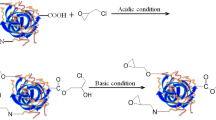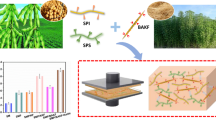Abstract
Soy protein isolate was reacted first with maleic anhydride and then hexamethylenediamine to synthesis soy protein isolate-based polyamides (SPIPA). Its bonding properties were measured by preparing laboratory three-layer plywood. Furthermore, a silane coupling agent (KH560), citric acid and maleic anhydride were added as cross-linkers to the SPIPA glue mix before hot pressing the panels. ATR FT-MIR and MALDI-ToF were used to determine the structures of the SPIPA, and thermomechanical analysis was used to analyze its thermomechanical properties. The results show that maleic anhydride reacts with amino acids in the soy protein molecule and then reacts with hexamethylenediamine to form carbamate-structured polyamides. This is confirmed by the ATR FT-MIR and MALDI-ToF results. Moreover, structural analysis indicates that a large number of branched structures are formed and occur in the SPIPA, rendering possible the formation of a network during curing, ensuring the bonding performance of the adhesive. The SPIPA adhesive presented good bonding strength and water resistance above the standard requirements of China National Standard GB/T 9846-2015. In particular, when maleic anhydride was added as a cross-linking agent, namely the SPIPA-MA adhesive, the panels’ dry and wet shear strengths were improved so that it can be considered as a suitable soy protein-based wood adhesive.




Similar content being viewed by others
References
Bel-Hassen R, Boufi S, Salon MCB, Abdelmouleh M, Belgacem MN (2008) Adsorption of silane onto cellulose fibers. II. The effect of pH on silane hydrolysis, condensation, and adsorption behavior. J Appl Polym Sci 108(3):1958–1968
Butler PJG, Harris JI, Hartley BS, Leberman R (1969) The use of maleic anhydride for the reversible blocking of amino groups on polypeptide chains. Biochem J 112(5):679
China National Standard GB/T 14074 (2006) Testing methods for wood adhesives and their resins. Standardization Administration of the Peoples Republic of China
China National Standard GB/T 17657 (1999) Test methods for evaluating the properties of wood-based panels and surface decorated wood-based panels. Standardization Administration of the Peoples Republic of China (SAC)
China National Standard GB/T 4897.5-2003 (2003) Requirements for load-bearing boards for use in humid conditions. Standardization Administration of the Peoples Republic of China (SAC)
Creighton TE (1996) Proteins: structures and molecular properties, 2nd edn. W.H. Freeman, New York
Del Menezzi C, Amirou S, Pizzi A, Xi X, Delmotte L (2018) Reactions with wood carbohydrates and lignin of citric acid as a bond promoter of wood veneer panels. Polymers 10(8):833
EN 312.2003 (2003) Particleboards—specifications. European Committee for Standardisation
EN 636:2012 (2012) Plywood—specifications. European Committee for Standardisation
Eslah F, Jonoobi M, Faezipour M, Afsharpour M, Enayati AA (2016) Preparation and development of a chemically modified bio-adhesive derived from soybean flour protein. Int J Adhes Adhes 71:48–54
Gao ZH, Zhang YH, Fang B, Zhang LP, Shi J (2015) The effects of thermal-acid treatment and crosslinking on the water resistance of soybean protein. Ind Crop Prod 74:122–131
Gui C, Wang G, Wu D, Zhu J, Liu X (2013) Synthesis of a bio-based polyamidoamine-epichlorohydrin resin and its application for soy-based adhesives. Int J Adhes Adhes 44:237–242
Hemmilä V, Adamopoulos S, Karlsson O, Kumar A (2017) Development of sustainable bio-adhesives for engineered wood panels—a Review. RSC Adv 7(61):38604–38630
Hettiarachchy NS, Kalapathy U, Myers DJ (1995) Alkali-modified soy protein with improved adhesive and hydrophobic properties. J Am Oil Chem Soc 72(12):1461–1464
Kamoun C, Pizzi A (2000) Particleboard IB forecast by TMA bending in MUF adhesives curing. Eur J Wood Prod 58(4):288–289
Lecourt M, Pizzi A, Humphrey P (2003) Comparison of TMA and ABES as forecasting systems of wood bonding effectiveness. Eur J Wood Prod 61(1):75–76
Lei H, Frazier CE (2015) Curing behavior of melamine-urea-formaldehyde (MUF) resin adhesive. Int J Adhes Adhes 62:40–44
Lei H, Pizzi A, Navarrete P, Rigolet S, Redl A, Wagner A (2010) Gluten protein adhesives for wood panels. J Adhes Sci Technol 24(8–10):1583–1596
Lei H, Du G, Wu Z, Xi X, Dong Z (2014) Cross-linked soy-based wood adhesives for plywood. Int J Adhes Adhes 50:199–203
Li K, Peshkova S, Geng X (2004) Investigation of soy protein-Kymene® adhesive systems for wood composites. J Am Oil Chem Soc 81(5):487–491
Lin Q, Chen N, Bian L, Fan M (2012) Development and mechanism characterization of high performance soy-based bio-adhesives. Int J Adhes Adhes 34:11–16
Liu Y, Li K (2002) Chemical modification of soy protein for wood adhesives. Macromol Rapid Commun 23(13):739–742
Liu Y, Li K (2007) Development and characterization of adhesives from soy protein for bonding wood. Int J Adhes Adhes 27(1):59–67
Liu W, Mohanty AK, Askeland P, Drzal LT, Misra M (2008) Modification of soy protein plastic with functional monomer with reactive extrusion. J Polym Environ 16(3):177–182
Pizzi A (2006) Recent developments in eco-efficient bio-based adhesives for wood bonding: opportunities and issues. J Adhes Sci Technol 20(8):829–846
Pizzi A (2016) Wood products and green chemistry. Ann For Sci 73(1):185–203
Pizzi A, Garcia R, Deglise X (1998) Thermomechanical analysis of entanglement networks: correlation of some calculated and experimental parameters. J Appl Polym Sci 67(9):1673–1678
Salon MCB, Abdelmouleh M, Boufi S, Belgacem MN, Gandini A (2005) Silane adsorption onto cellulose fibers: hydrolysis and condensation reactions. J Colloid Interface Sci 289(1):249–261
Schmidt V, Giacomelli C, Soldi V (2005) Thermal stability of films formed by soy protein isolate–sodium dodecyl sulfate. Polymer Degrad Stab 87(1):25–31
Simon C, George B, Pizzi A (2002) Copolymerization in UF/pMDI adhesives networks. J Appl Polymer Sci 86(14):3681–3688
Sun X, Bian K (1999) Shear strength and water resistance of modified soy protein adhesives. J Am Oil Chem Soc 76(8):977–980
Umemura K, Ueda T, Kawai S (2012a) Characterization of wood-based molding bonded with citric acid. J Wood Sci 58(1):38–45
Umemura K, Ueda T, Munawar SS, Kawai S (2012b) Application of citric acid as natural adhesive for wood. J Appl Polymer Sci 123(4):1991–1996
Umemura K, Sugihara O, Kawai S (2013) Investigation of a new natural adhesive composed of citric acid and sucrose for particleboard. J Wood Sci 59(3):203–208
Vnučec D, Kutnar A, Goršek A (2017) Soy-based adhesives for wood-bonding—a review. J Adhes Sci Technol 31(8):910–931
Xi X, Pizzi A, Delmotte L (2018) Isocyanate-free polyurethane coatings and adhesives from mono-and di-saccharides. Polymers 10(4):402
Xi X, Wu Z, Pizzi A, Gerardin C, Lei H, Zhang B, Du G (2019) Non-isocyanate polyurethane adhesive from sucrose used for particleboard. Wood Sci Technol 53(2):393–405
Xie Y, Hill CA, Xiao Z, Militz H, Mai C (2010) Silane coupling agents used for natural fiber/polymer composites: a review. Compos A Appl Sci Manuf 41(7):806–819
Zhong Z, Sun XS, Wang D, Ratto JA (2003) Wet strength and water resistance of modified soy protein adhesives and effects of drying treatment. J Polym Environ 11(4):137–144
Acknowledgements
The first and the fourth author thank the China Scholarship Council for the study bursary granted to them. The LERMAB of the University of Lorraine is supported by a grant by the French National Research Agency (ANR) as part of the Laboratory of Excellence (Labex) ARBRE. This paper was also funded by ERA CoBioTech, L’Agence nationale de la recherche (ANR) under WooBAdh title.
Author information
Authors and Affiliations
Corresponding author
Additional information
Publisher's Note
Springer Nature remains neutral with regard to jurisdictional claims in published maps and institutional affiliations.
Rights and permissions
About this article
Cite this article
Xi, X., Pizzi, A., Gerardin, C. et al. Soy protein isolate-based polyamides as wood adhesives. Wood Sci Technol 54, 89–102 (2020). https://doi.org/10.1007/s00226-019-01141-9
Received:
Published:
Issue Date:
DOI: https://doi.org/10.1007/s00226-019-01141-9




